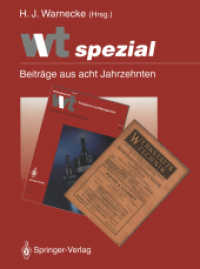- ホーム
- > 洋書
- > 英文書
- > Science / Mathematics
Full Description
Cyber-Physical Systems (CPS) is featured by the tight integration of cyber and physical components. CPS has made major advances with a broad societal impact. Now in the era of Industry Revolution 4.0, CPS is considered as an enabling technology. Combined with autonomy, big data, machine learning and internet of things, CPS empowers systems with greater intelligence to address uncertainties, unknowns, attacks, and unexpected events.
This book highlights the latest advances and explores the new trends in the design and implementation of smarter Cyber-Physical systems (CPS). It introduces integrated model-based and data-driven solutions for CPS that demonstrate features including both adaptability and interpretability. Key topics covered include reinforcement learning, digital twin and large-scale networks. The book then presents the latest codesign techniques that address practical computation, networking, control, and physical constraints. It examines important issues related to human CPS, safety, resilience and privacy. The chapters feature the tight integration of theory and practice, including problems motivated from applications, fundamental research development that are generally applicable, and implementation in real system applications. A wide range of CPS applications are covered, including robotics, autonomous driving, unmanned aerial vehicles and smart cities.
Contents
Preface. PART I: CPS FUNDAMENTALS AND NEW TRENDS. Fractional-Order Distributed Parameter Systems for Smarter Cyber-Physical Systems: Challenges and Opportunities. On Separation Between Learning and Control in Partially Observed Markov Decision Processes. On the Impact of Sensor-Actuator Clock Offsets on Off-Policy Reinforcement Learning. Decentralized Analysis and Controller Synthesis of Networked Systems. Lyapunov Analysis for Discrete-Time Stochastic Systems with Application to Network Consensus. Event-Driven Distributed Cyber-Physical Systems. Digital Twins in CPS: The State of the Art and Future Trends. PART II: CPS DESIGN AND CO-DESIGN TECHNIQUES. Game-Theoretic Decision-Making for Autonomous Driving. Cyber-Physical Systems for Human-Centric Automated Vehicles. Learning-Based Control of Autonomous Vehicles in Mixed Vehicular Platoons. Robot Absolute Positioning and Obstacle Avoidance: A Cyber-Physical System Approach. Specification-Guided Safe Learning for Robotic Systems. On-Demand Emergency Aerial Communication Using Directional Antennas: A CPS Co-design Approach. PART III: SAFETY, RESILIENCE AND PRIVACY. Hybrid System-based Cyber-Attack Identification and Mitigation. Online Identification of Adversarial Cognitive Ability in Dynamic Games. Constructing Safety Certificates for Unknown Linear H2 and H∞ Control Problems. Scalable Attack-Resilient Algorithms for Coordination in Networked Cyber-Physical Systems. Resilient Distributed Learning in Multi-UAV Systems. Privacy-Aware Control of Cyber Physical Systems. Index.








